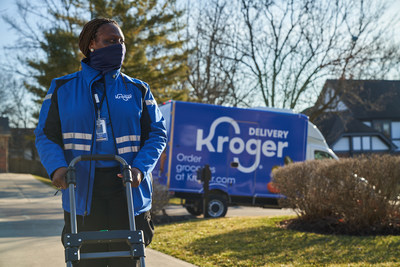The coronavirus pandemic has shaped many trends throughout the business world, but perhaps none as notably as those within the grocery industry. The world changed practically overnight and grocers were left with the heavy burden of not only making their stores and employees as safe as possible, but also making sure shoppers still had access to groceries. E-commerce went from a burgeoning technology to a downright necessity in the blink of an eye.
The FMI Food Retailing Industry Speaks 2020 report found that grocers, on average, saw online sales increase 300% during the early days of the pandemic. FMI also found that online grocery shoppers grew to 64% of all adults in the US and 29% of online shoppers placed an order each week.
As a result of these changes, eMarketer predicts that online grocery sales will total more than $100 billion this year and represent 12.4% of all e-commerce sales in the US. Food retailers have already seen the windfall from this e-commerce growth, with Walmart’s online sales growing 37% and Sprouts Farmers Market experiencing a 221% increase in e-commerce sales for the first quarter, and Albertsons seeing a 282% increase in online sales for its quarter ending Feb. 27.
E-commerce and omnichannel shopping are here to stay, and grocers are going big when it comes to offering customers an online shopping experience. The beginning of the pandemic was a huge impetus behind the initial interest in using e-commerce to get groceries, but the depth and breadth of services grocers have made available since then has only proliferated.
Grocers make way for change
Kroger, which was recently named the No. 9 US e-commerce company by eMarketer, saw more than $11 billion in e-commerce sales in 2020, representing 79% year-over-year growth. The grocer is hard at work on its cavalcade of Ocado-powered micro-fulfillment centers, the first of which recently opened near its hometown of Cincinnati and utilizes robotics, vertical integration and machine learning to pick and deliver groceries for digital customers.
“The momentum we’re experiencing is well-timed with the evolution of Kroger Delivery, underpinning the permanent shift in grocery consumer behavior and need for enterprising and modern e-commerce and last-mile solutions — today’s true competitive horsepower,” said Kroger CEO Rodney McMullen in a press statement.
The retailer is also putting resources into its hub-and-spoke distribution capabilities in Central Florida, which allows Kroger groceries to be delivered to residents in a 90-mile radius even though there are no physical stores in the area. A drone delivery test is underway in Ohio, and Kroger is also leveraging its customer loyalty program to beef up its precision marketing operations.
Albertsons is also deep into the micro-fulfillment business thanks to a partnership with Takeoff Technologies. The company also formed a partnership with Google that has resulted in the rollout of hyperlocal shoppable maps, artificial intelligence-powered conversational commerce and predictive grocery lists. Yet another partnership with Adobe is allowing Albertsons to use its Experience Cloud to analyze data collection and better understand what customers want.
“After growing our e-commerce business 258% year over year, equipping over a thousand stores with curbside pickup and refreshing our mobile app, we are investing now in differentiated services such as temperature-controlled pickup kiosks, two-hour fulfillment and even remote-controlled delivery robots,” said Albertsons’ Chris Rupp in a press statement. “As we boost our omnichannel offerings, we are relying on Adobe Experience Cloud apps to help us get more value from data and leverage cross-channel insights to improve the overall shopping experience.”
Hy-Vee has also formed a high-profile partnership with Google that will help the retailer personalize the online experience for customers while also enhancing its existing Aisles Online services. Walmart, meanwhile, is revamping its in-home delivery service while also seeing major growth for its Walmart+ program.
Smaller grocers are also ramping up their e-commerce capabilities. Food Lion recently expanded its grocery pickup services, Big Y launched its automated micro-fulfillment center next to a store in Chicopee, Mass., to cover online orders for 7,000 customers per week, and Stater Bros. Markets partnered with Mercatus to create a scalable e-commerce platform.
Moving forward with digital grocery
Food retailers are still in the early stages of their digital revolution, and companies like Albertsons know there is a lot of learning and growing ahead of them. “We are taking an approach where we’re emphasizing quality,” said CEO Vivek Sankaran during a virtual conference last month. “We are being creative about it. We’re expanding it. And our overall business is good.”
Hy-Vee CEO Randy Edeker also recognizes the changing nature of grocery e-commerce brought on by the pandemic. “I think we have created habits for a lifetime now that are going to continue on. I’m sure they will evolve,” Edeker told Progressive Grocer. “There’ll be some new players, I’m sure, that come into some of these spaces. But your digital business today is a mainstay, and one that you’re going to keep investing [in,] and [that] will continue to evolve how we do business moving forward.”
Related stories:
- 5 food & beverage trends accelerated, altered or accentuated by the pandemic
- Will the future food supply chain reflect pandemic-era changes?
- Why consumer data is key to growth for F&B companies
_______________________________________________
If you enjoyed this article, you can sign up for the FMI dailyLead, ProChef SmartBrief or Restaurant SmartBrief to get news like this in your inbox. For even more great news content, sign up for any of SmartBrief’s 275+ free email newsletters today, free.
